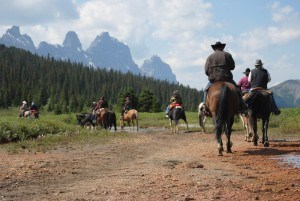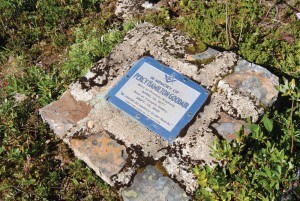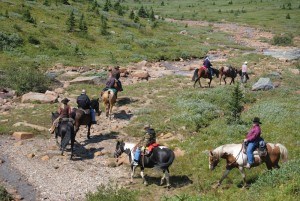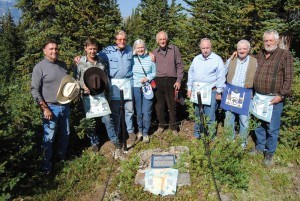
Tucked away deep in the backcountry, between towering peaks and flowering meadows, lays the remains of a man with an incredible story.
That man was Percy Hamilton Goodair a park warden and an original member of Jasper’s masonic lodge, who was killed by a grizzly bear in the Tonquin Valley in 1929.
To commemorate his death, last week six masons from Jasper Park Lodge 143 held a masonic memorial service at his gravesite near Amethyst Lake, in the Tonquin Valley.
In attendance was Goodair’s great, great niece, Drewe Hammett and her husband Richard Hammett, who travelled more then 3,000 kms from Burlington, Ont. to take part in the memorial service.
With 12 horses, the group set off from Portal Creek on Aug. 10 for a four-night trip into the heart of the Canadian Rockies.
Following the thundering roar of Portal Creek, the group carefully traversed scree before climbing through subalpine forests and emerging some 2,200 metres above sea level at Maccarib Pass.
Dotted with purple and yellow wildflowers, the alpine meadow skirts the tree line before slowly descending towards Amethyst Lake and the jagged peaks of the Ramparts.
With a light breeze blowing up the valley, riders crossed a babbling creek as they made their way to their final destination—the Tonquin Valley Backcountry Lodge on the shores of Amethyst Lake.
The six-hour trek, including a 30-minute lunch break, was no easy feat as horses navigated muddy trails and loose rock. Fortunately the weather was on their side, making for beautiful vistas along the way.
“Percy dedicated his life up here,” said Harry Home, the worshipful master for Jasper Park Lodge 143 and organizer of the trip.
“Masonry teaches you that life should be a temple of peace and this was his temple of peace,” said Home, in reference to the Tonquin Valley.

Like so many that have come after him, Goodair found peace and serenity in the remote wilderness of the Tonquin Valley.
But that serenity was interrupted weeks before his death when he came face-to-face with a grizzly while patrolling the Tonquin Valley on horseback.
According to one version of the story, Goodair was checking on one of his cabins when he startled an unsuspecting bear. The grizzly rose up on his hind legs and emitted a rumbling growl, causing Goodair’s horse to rear.
Before Goodair could draw his Lee-Enfield from his saddle scabbard, the bear dropped to all fours and lumbered off into the forest. When he arrived at the cabin, Goodair noticed the door had been torn from its hinges and the food cache had been ransacked.
A week later he came upon another cabin that had been looted in a similar fashion and he vowed to find the bear and kill it.
With the incidents fresh in his mind, Goodair headed back to Jasper and told the chief warden, Dick Langford, about his run in with the grizzly and the damage it had done to two of his cabins.
Langford offered Goodair a chance to patrol a different area of the park that would be closer to town, but Goodair refused.
In early September of 1929, Goodair returned to the Tonquin. A week later, on Tuesday, Sept. 18, Goodair phoned in. All was well. In those days it was mandatory for wardens to phone the chief warden every Tuesday morning at 11 a.m. If they failed to do so, a party would be dispatched to find out if they were in trouble.
The following Tuesday, Sept. 25, the phone never rang. According to one story, Langford waited anxiously for a phone call that never came.
That evening Langford called the town warden, Frank Wells, and told him to gather a couple men and head to Amethyst Lake first thing in the morning.
The next morning, Wells left with Charlie Matheson and “Happy” Reilly, both veteran mountain men.
When the trio arrived at the cabin, about a foot of snow had fallen and there were no footprints.
As they entered the cabin, it was clear Goodair had been interrupted while preparing a meal. Scanning the room they noticed his loaded rifle was beside the door, but he was nowhere to be found.
While searching for more clues about his whereabouts, the men were drawn to Wells’ dog who was barking frantically behind the house. There behind his cabin laid the lifeless body of Goodair. He had claw marks on his face and a handkerchief stuffed under his arm in an attempt to stop the bleeding from an opened artery. Reports suggest his death was swift and merciful with a single blow to the left side of his chest.
After notifying the chief of the tragedy, the three wardens set out to avenge his death. By nightfall they found a set of grizzly tracks and followed them for the next two days, killing two other grizzlies along the way, but were unable to find the culprit.
While cleaning up Goodair’s cabin, the wardens found a message. In it Goodair requested that if he were to die while he was in the Tonquin he wanted to be buried on the hillside beside his cabin.
“I think Percy Goodair must have been an exceptional man,” said Drewe. “He lived what he believed in and I think that’s something we can all draw a lesson from.”

For both Drewe and Richard Hammett, this was their second time visiting Goodair’s grave.
“Growing up we were told the story of uncle Percy who was killed by a grizzly bear, but we never really knew the details,” said Drewe.
“About 15 years ago Richard and I were visiting a friend in the west and we were going to climb Mount Edith Cavell, and I happened to turn around and there was this sign saying Tonquin Valley,” recalled Drewe.
“Suddenly something that had been sort of magical and mystical became a reality. The Tonquin Valley really existed.”
Intrigued by her discovery, she began doing some research about her great, great uncle and soon learned about his extraordinary life.
Prior to joining the warden service in Jasper National Park, Goodair served in the Imperial Army in Africa as a lieutenant, and worked for a short time with the British foreign office in Nigeria.
After immigrating to Canada from England, Goodair operated a cattle ranch in Cochrane, Alta. before enlisting with the army during the First World War.
Amazed by his story, Drewe contacted her relatives and organized a trip to visit his grave in 2005.
In all, 11 relatives from across North America and England came to Jasper to pay their respects at the foot of Goodair’s grave.
“We figured this way uncle Percy will live on in the minds of the next generation,” she said, explaining several younger family members also made the trip.
In 2005, they hiked into the Tonquin from Mount Edith Cavell, following the Astoria River, and stayed at the Tonquin Amethyst Lake Lodge, on the opposite side of lake.
To get to Goodair’s grave, they took a rowboat across the lake to symbolize Goodair’s journey across the Atlantic Ocean when he first emigrated from Preston, England.
“It certainly gave us a sense that uncle Percy was a piece of the family, which was important when you think about the violence of his death and how alone he must have felt,” said Drewe.

It was eight years later that the Hammett’s received an unexpected phone call from Jasper; on the other end of the line was Home.
“I was absolutely delighted,” recalled Drewe. “We were thrilled to be invited to be a part of the masonic lodge’s celebration of Percy’s life.”
To commemorate Goodair’s death, Home led a masonic memorial service with his fellow brethren from Jasper Park Lodge 143.
Before the ceremony began, each mason wore their masonic apron and stood alongside Goodair’s grave according to their rank.
After the opening remarks, each person in attendance introduced themselves to the group followed by the recital of a short prayer.
Following tradition, a lambskin apron was then placed on Goodair’s grave and each person laid a small piece of spruce to symbolize a sprig of acacia, an important symbol in Freemasonry.
“I think it is a fitting tribute for one of the early servants of the national park to be laid to rest in the land he loved,” said Home.
With files from Albert Baker
Paul Clarke
[email protected]
